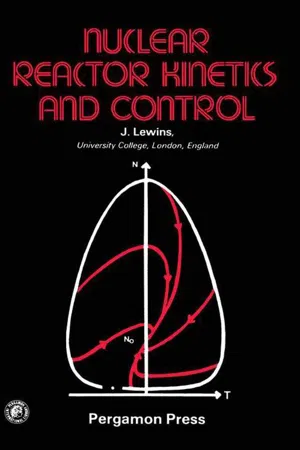
- 278 pages
- English
- ePUB (mobile friendly)
- Available on iOS & Android
Nuclear Reactor Kinetics and Control
About this book
Nuclear Reactor Kinetics and Control highlights the application of classical control methods in the frequency space to the dynamic processes of a nuclear reactor. This book contains nine chapters and begins with an introduction to some important mathematical theories related to nuclear engineering, such as the Laplace and Fourier transforms, linear system stability, and the probability theory. The succeeding chapters deal with the frequency space of classical linear design. A chapter describes a stochastic model for the "lumped reactor and presents equations that measure the departure from the mean, as well as representative experiments or applications of the theory to neutron detection. The discussion then shifts to the aspects of reliability and its consequences for safety of nuclear reactors and some techniques for nonlinear studies centered on the use of the state space and its equations in the time domain. The final chapter introduces the modern electric analogue computer and derives the patching or programming rules that can be use to find solutions to problems of interest using the analogous behavior of electric circuits. This chapter also provide examples of intrinsic interest in nuclear engineering showing the programming involved and typical results, including the slower transients of xenon poisoning and fuel burn-up. This book is intended for nuclear engineers, physicists, applied mathematicians, and nuclear engineering undergraduate and postgraduate students.
Frequently asked questions
- Essential is ideal for learners and professionals who enjoy exploring a wide range of subjects. Access the Essential Library with 800,000+ trusted titles and best-sellers across business, personal growth, and the humanities. Includes unlimited reading time and Standard Read Aloud voice.
- Complete: Perfect for advanced learners and researchers needing full, unrestricted access. Unlock 1.4M+ books across hundreds of subjects, including academic and specialized titles. The Complete Plan also includes advanced features like Premium Read Aloud and Research Assistant.
Please note we cannot support devices running on iOS 13 and Android 7 or earlier. Learn more about using the app.
Information
Introductory Review
Publisher Summary
Table of contents
- Cover image
- Title page
- Table of Contents
- Other Pergamon Titles of Interest
- Copyright
- Dedication
- ERRATA
- Preface
- Acknowledgements
- Chapter 1: Introductory Review
- Chapter 2: Neutron and Precursor Equations
- Chapter 3: Elementary Solutions of the Kinetics Equations at Low Power
- Chapter 4: Linear Reactor Process Dynamics with Feedback
- Chapter 5: Power Reactor Control Systems
- Chapter 6: Fluctuations and Reactor Noise
- Chapter 7: Safety and Reliability
- Chapter 8: Nonlinear Systems; Stability and Control
- Chapter 9: Analogue Computing
- Index
- Inside Back Cover